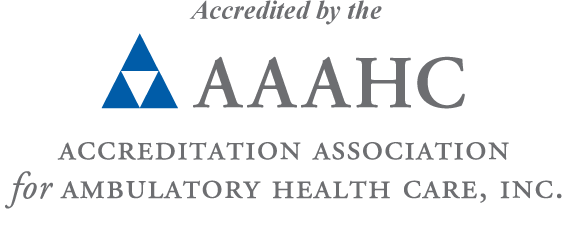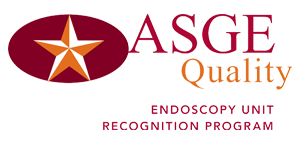Esophagogastroduodenoscopy (EGD)
General Information:
- Description: A long, flexible tube with a camera mounted on the end (endoscope) is inserted into the mouth. The scope is then guided through the esophagus, stomach, and into the duodenum (first part of the small intestines). This allows for viewing of the internal lining of the upper intestines directly. A Gastroenterologist performs the test with assistance from a nurse in a hospital, endoscopy suite or doctor’s office. The Gastroenterologist interprets the results. If specimens are obtained, a Pathologist interprets the results. The test takes 5-15 minutes to complete.
- Discomfort – An intravenous line has to be placed. Depending on the level of sedation, there may be some discomfort as the scope is passed and as air is instilled into the intestines.
- Results – The Gastroenterologist’s interpretation is available immediately; 2-3 days for results from tissue samples obtained.
- Risks of Procedure – Perforation of the intestines, bleeding, aspiration of gastric juices into lungs.
- Average Cost – $$-$$$
- Other Names – Endo, Upper Gastrointestinal (GI) Endoscopy
Indications for the Test
- To examine and take tissue samples of abnormalities identified by other tests (UGI X-ray or CT) of the esophagus, stomach, and duodenum.
- To search for the cause of symptoms thought to come from the UGI tract such as swallowing problems, chest pain, nausea or vomiting, heartburn, loss of appetite and weight loss, diarrhea, or GI bleeding.
- To stop bleeding from the upper GI tract, stretch open the esophagus, or remove foreign bodies.
- Some persons may be given an antibiotic before the test if there is a risk of infection associated with the test.
Preparation
- Nothing should be consumed for 8 hours before the test, except medications as directed by your doctor.
- Aspirin, non-steroidal anti-inflammatory drugs (aspirin substitutes), blood thinners, and anticoagulants should not be taken for five days before the test to reduce the risk of bleeding.
- Arrangements should be made for someone to drive you home after the test.
- You wear a hospital gown. Dentures are removed before the test.
Procedure
- Monitors are attached to observe the blood pressure, pulse rate, and oxygen level of the blood. Supplemental oxygen is given via the nose.
- An intravenous line is placed for a sedative to be given. A local anesthetic may be sprayed into the throat to suppress the gag reflex.
- A mouthpiece is placed between your teeth to prevent you from accidentally biting the endoscope.
- Your throat may be sprayed with a medication to suppress the gag reflex. You receive a sedative intravenously. Depending on the level of sedation, you may drift off to sleep during the procedure.
- After you are sedated, an endoscope is passed through your mouth and guided down into the duodenum (the first part of the small intestines just beyond the stomach). The image from the endoscope is displayed on a TV monitor.
- Air is instilled into the intestines via the endoscope to aid in viewing the inside lining of the intestines.
- Tissue samples can be taken via the endoscope. If a narrowed area is found, it can be dilated via the endoscope.
After the Procedure
- You are monitored in the recovery area until the sedation wears off.
- Once the sedation wears off, you may have someone drive you home.
- If your throat was sprayed with oral sedation, you should not eat or drink until it wears off (up to 2 hours after the test).
- You will belch and pass flatulence until the air instilled during the study has been passed. A mild sore throat is to be expected after the test for several days.
- If you have severe abdominal pain or pass blood, notify your doctor immediately.
Factors Affecting Results
- The presence of food or blood in the stomach can limit the ability to examine the gastric lining.
Advantages
- The lining of the esophagus, stomach, and duodenum can be visualized directly.
- If an abnormality is identified, tissue can be obtained for analysis, bleeding can sometimes be stopped, and narrowed areas can sometimes be dilated.
Disadvantages
- The test is an invasive procedure.
- Depending on the level of sedation, there may be discomfort associated with the test.
Frequently Asked Questions
- Do I take my blood pressure medicine before the test? Yes.
- I take blood thinners. What do I do? Do not take blood thinners for four days prior to the test.
- I’m on dialysis. Are there any special instructions? Drink Colyte prep instead of Fleets the night before the test.
- My test is scheduled for late afternoon. Can I eat something prior to the test? No, just clear liquids up until 4 hours prior to the test.
- I’m a diabetic. Do I take my normal amount of insulin? Take ½ of your normal dosage the night before the test. Do not take insulin the morning of the test. If you take oral medication for your diabetes, do not take your medication the morning of the test.
- Can I take aspirin prior to the test? Do not take aspirin 4 days prior to the test.
- Can I take iron? Do not take iron 4 days prior to the test.
- Can I take my heart medicine? Yes, take as normal.


